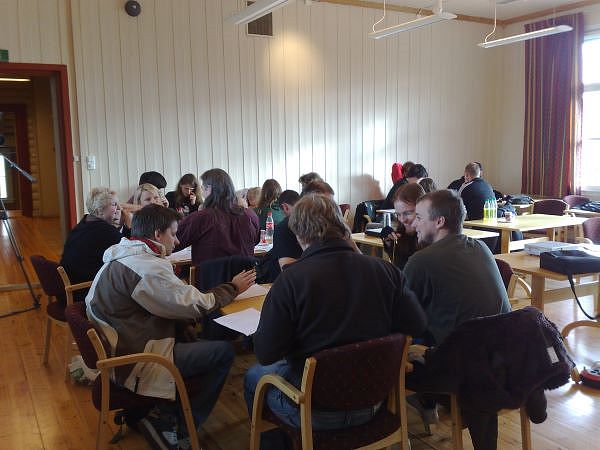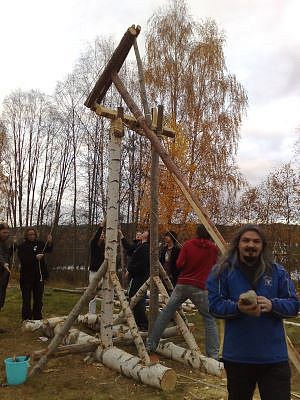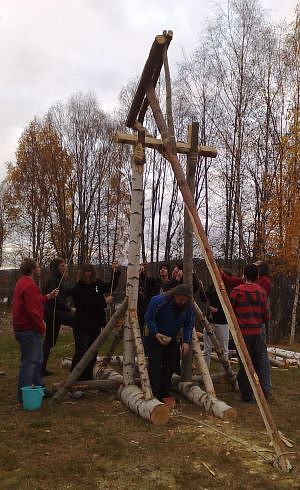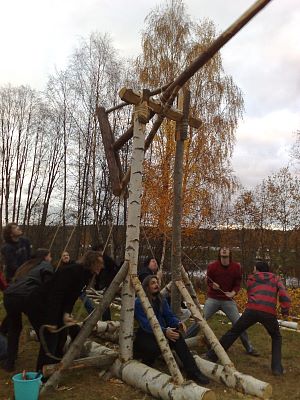Workshops and Siege Engines in Norway!
 Wow, did I have fun at Hedmark University College in Norway. I met the nice folks there when I went to the JoinGame conference a few months ago, and they seemed really interested in a visit. This week I got the opportunity. I flew to Oslo and then took the train to Rena.
Wow, did I have fun at Hedmark University College in Norway. I met the nice folks there when I went to the JoinGame conference a few months ago, and they seemed really interested in a visit. This week I got the opportunity. I flew to Oslo and then took the train to Rena.
 The college has three campuses, and this one is in a small but very pretty town in eastern Norway. The province of Østerdalen is a mountainous area used by the military for special forces training -- lots of lakes and rivers. All the leaves were turning color and there was a decided chill in the air.
The college has three campuses, and this one is in a small but very pretty town in eastern Norway. The province of Østerdalen is a mountainous area used by the military for special forces training -- lots of lakes and rivers. All the leaves were turning color and there was a decided chill in the air.
The college has an ordinary modern building, but I gave my workshops in a separate place -- a old wooden building made of logs that smelled wonderful. There was a church in the town built in the same style, but unfortunately I didn't get a chance to look inside.
The students all seemed to be very interested in the work and I think they enjoyed themselves. In addition to learning game programming they're also designing a board game, and the best one may be published. I'm always pleased when I find game design students working on a non-computerized game -- I think it's important for them to realize that games are games regardless of what medium they're in. Obviously the computer allows us to do things we can't do otherwise, but the heart of the experience is still the same: gameplay.
The night I arrived I had a surprisingly good Chinese meal (Rena has only 7000 people but two Chinese restaurants) with Sule Yildirim, the head of the computer science department there. On the second night, after the workshop, all the students and faculty headed out to an Italian place that served gyro (doner) kebab pizza, which was new to me.
 One of the highlights of the visit for me was getting to see, and indeed release, a small home-made trebuchet. If you're not a fan of medieval siege engines this probably won't mean much to you, but in my experience a lot of computer people love them. This one was built in a single day by one of the faculty, Simon McCallum, a kiwi whom I met four years ago at the Fuse conference in Dunedin, New Zealand.
One of the highlights of the visit for me was getting to see, and indeed release, a small home-made trebuchet. If you're not a fan of medieval siege engines this probably won't mean much to you, but in my experience a lot of computer people love them. This one was built in a single day by one of the faculty, Simon McCallum, a kiwi whom I met four years ago at the Fuse conference in Dunedin, New Zealand.The Romans had a kind of catapult (known in the Middle Ages as a mangonel) that worked with a spring made of tightly twisted rope, but as Simon explained to me, they were dangerous. If something went wrong, all that pent-up energy had to go somewhere, and the thing could literally fly to pieces, killing the crew. I knew how mangonels worked, but it never occurred to me what would happen if the frame gave way.
The trebuchet is a later and safer invention. It's essentially a sling, extended by a long pole. You pull down on one end of the pole,
 and the other rises up and slings the projectile. The later and more famous version of the trebuchet used very heavy (many tons) weights to throw stones weighing hundreds of pounds. Simon's is an earlier design, the traction trebuchet. The crew simply pull down on ropes to sling the arm. The advantage of this approach is that all the energy is in the human beings -- the device is completely safe to its users provided that the sling is adjusted properly. For maximum distance, the projectile should leave the sling heading upwards at a 45 degree angle.
and the other rises up and slings the projectile. The later and more famous version of the trebuchet used very heavy (many tons) weights to throw stones weighing hundreds of pounds. Simon's is an earlier design, the traction trebuchet. The crew simply pull down on ropes to sling the arm. The advantage of this approach is that all the energy is in the human beings -- the device is completely safe to its users provided that the sling is adjusted properly. For maximum distance, the projectile should leave the sling heading upwards at a 45 degree angle.In the pictures you can see Simon showing off one of the stones it throws (it weighed about five pounds), then getting ready to put it in the sling, and finally, at the moment of release as everybody pulls down on the ropes. I got to sit where Simon did and throw a rock of my own.
Now consider this: This device took one day to build, cost almost nothing, and could throw a heavy stone well over a hundred yards. When you imagine a determined army armed with a dozen or so of these devices on a far larger scale, it's no wonder that castles had walls 12 feet thick.
 A steady rain of heavy rocks would unnerve anyone.
A steady rain of heavy rocks would unnerve anyone.On the second day I gave a lecture about character design and a short workshop on serious games. That evening I had the pleasure of attending a concert of various Norwegian pop and folk songs put on by the townsfolk. One of the faculty, Tone Vold, was the stage manager and got me the ticket. Even though I didn't understand a word, it was a lot of fun. I had forgotten how enjoyable live performances are.
Unfortunately the computer science program at Hedmark is under threat -- the administration says there aren't enough students. It would be a shame to lose it... I'd really like to visit again some time.


<< Home